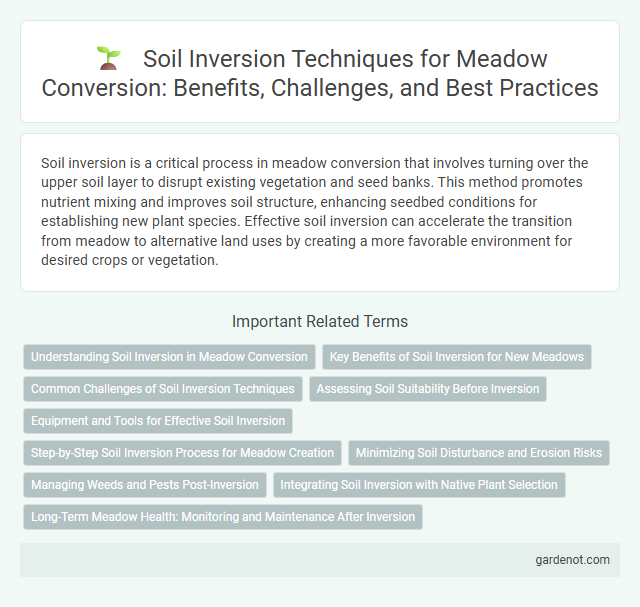Soil inversion is a critical process in meadow conversion that involves turning over the upper soil layer to disrupt existing vegetation and seed banks. This method promotes nutrient mixing and improves soil structure, enhancing seedbed conditions for establishing new plant species. Effective soil inversion can accelerate the transition from meadow to alternative land uses by creating a more favorable environment for desired crops or vegetation.
Understanding Soil Inversion in Meadow Conversion
Soil inversion in meadow conversion involves turning the soil over to a depth of 20-30 cm, which alters soil structure and disrupts existing vegetation, promoting the establishment of new grass species. This process improves aeration, nutrient availability, and microbial activity essential for healthy pasture development. Proper understanding of soil inversion dynamics enhances successful meadow restoration and long-term productivity.
Key Benefits of Soil Inversion for New Meadows
Soil inversion enhances soil structure by burying compacted layers and bringing nutrient-rich subsoil to the surface, promoting healthier root development in new meadows. This process improves drainage and aeration, reducing waterlogging and fostering microbial activity essential for plant growth. As a result, soil inversion creates an optimal growing environment that supports diverse native flora and increases meadow biodiversity.
Common Challenges of Soil Inversion Techniques
Soil inversion techniques in meadow conversion often face challenges such as disruption of soil structure, leading to reduced aeration and water retention. This process can also cause loss of beneficial soil microorganisms and increase erosion risks, impacting long-term soil fertility. Managing compaction and balancing nutrient redistribution remain critical concerns for successful soil inversion outcomes.
Assessing Soil Suitability Before Inversion
Assessing soil suitability before inversion requires analyzing texture, structure, and drainage capacity to ensure optimal conditions for successful meadow conversion. Soil tests measuring pH, nutrient levels, and organic matter content help determine whether inversion will improve soil health or cause degradation. Proper evaluation minimizes risks such as erosion and nutrient loss, promoting long-term sustainable land management.
Equipment and Tools for Effective Soil Inversion
Soil inversion during meadow conversion requires specialized equipment such as moldboard plows or chisel plows to effectively turn and loosen the soil, promoting aeration and weed control. Heavy-duty tractors with adjustable plow depths ensure consistent inversion across varied soil conditions, optimizing seedbed preparation. Complementary tools like rotary harrows or cultivators refine soil texture post-inversion, enhancing moisture retention and nutrient availability for successful meadow establishment.
Step-by-Step Soil Inversion Process for Meadow Creation
Soil inversion begins with deep plowing using a heavy-duty invert plow to turn the existing topsoil and subsoil layers upside down, effectively burying weed seeds and unwanted vegetation. Next, the inverted soil is left to rest and settle for several weeks to promote microbial activity and improve soil structure before reseeding. Finally, the soil surface is lightly harrowed to create a fine seedbed ideal for sowing native meadow species.
Minimizing Soil Disturbance and Erosion Risks
Soil inversion techniques in meadow conversion prioritize minimizing soil disturbance by carefully flipping soil layers to retain organic matter and microbial activity, which supports ecosystem recovery. Controlled inversion depth reduces erosion risks by preserving surface structure and minimizing bare soil exposure to wind and water. This approach enhances soil stability and promotes rapid vegetation establishment, crucial for sustainable meadow restoration.
Managing Weeds and Pests Post-Inversion
Soil inversion disrupts weed seed banks by burying surface weed seeds deep, reducing their germination and minimizing pest habitats, which enhances crop establishment. Effective post-inversion management includes targeted herbicide applications and timely monitoring to prevent weed resurgence and control pest populations. Integrating crop rotation and cover crops further suppresses weed growth and improves soil health after soil inversion.
Integrating Soil Inversion with Native Plant Selection
Soil inversion improves soil structure by flipping subsoil to the surface, enhancing aeration and nutrient availability crucial for native plant establishment in meadow conversion. Integrating soil inversion with native plant selection supports growth of deep-rooted species that stabilize soil and increase biodiversity. This combination promotes long-term ecosystem resilience and carbon sequestration in restored meadows.
Long-Term Meadow Health: Monitoring and Maintenance After Inversion
Soil inversion enhances long-term meadow health by improving soil structure and nutrient availability, which supports diverse plant growth and prevents weed invasion. Regular monitoring of soil pH, moisture levels, and organic matter content ensures sustainable fertility and ecosystem balance. Maintenance practices such as reseeding native species and controlling invasive plants are crucial to preserving meadow resilience after inversion.
Soil inversion Infographic

 gardenot.com
gardenot.com